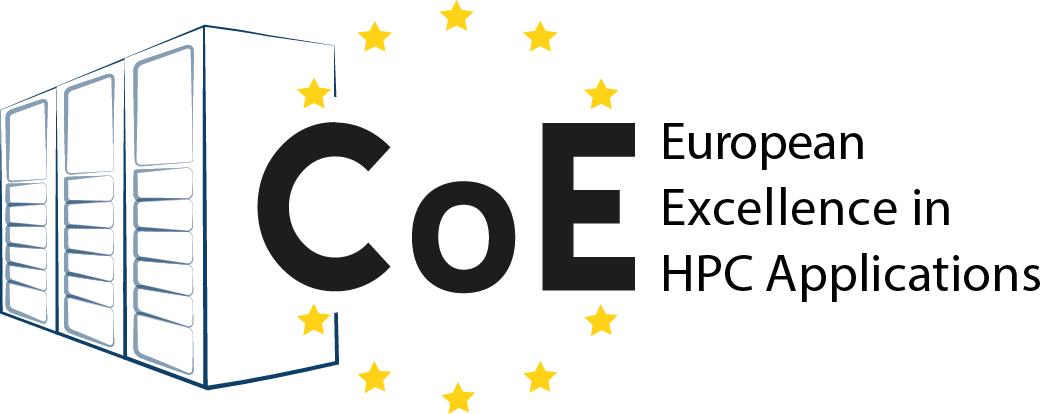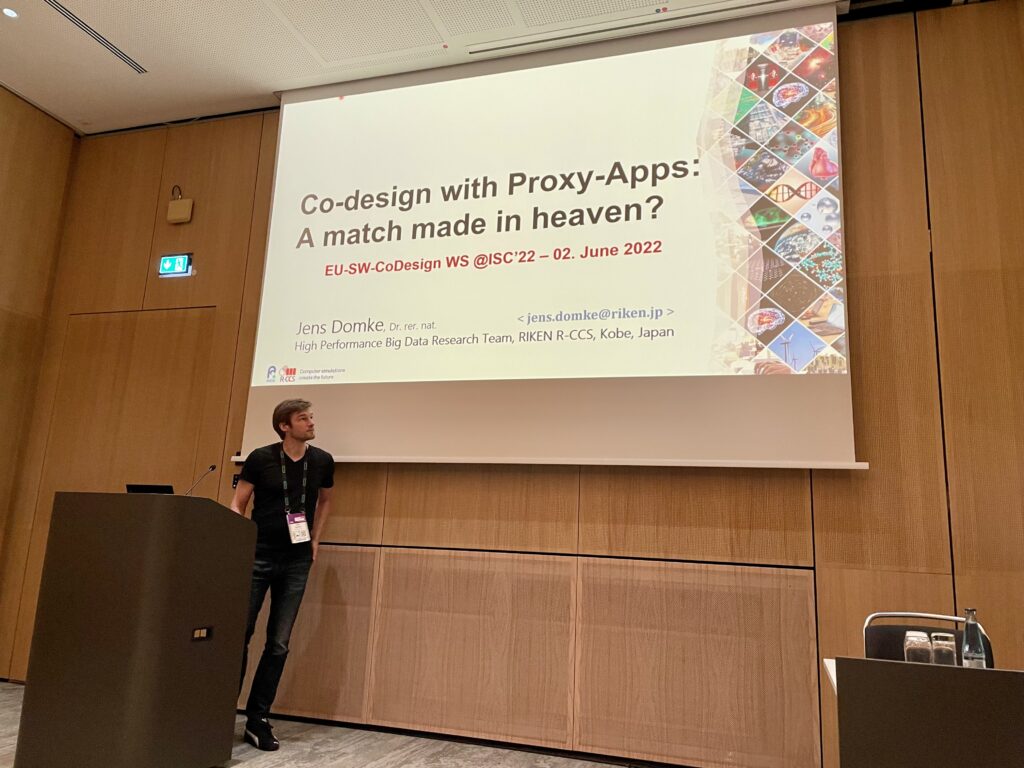
The recent HiPEAC Conference in Barcelona brought together a remarkable convergence of expertise and innovation in high-performance computing (HPC). Between January 20-22, 2025, workshops organized by 16 European Centres of Excellence (CoEs) tackled the pivotal transition from petascale to exascale computing, showcasing the collaborative power of the European HPC community.
Women Leading HPC
The workshops were designed not only to address technical challenges but also to defy norms in a field where the contributions from women and people from historically marginalized backgrounds often go unnoticed. From early-career researchers to established leaders, the speakers represented the depth and diversity of talent shaping the present and future of HPC.

Marta García-Gasulla, one of the main organizers of the workshops and a researcher at the POP3 Centre of Excellence with her presentation on lessons learned and challenges in assessing European HPC codes. // Photo by Elisabetta Boella.
ChEESE researchers on HiPEAC
Alejandra Guerrero, ChEESE researcher from GEO3BCN-CSIC presented on ash fallout assessment in the HPC era, highlighting the role of advanced computational tools in natural hazard research.
Arnau Folch, ChEESE PI from GEO3BCN-CSIC, contributed to the roundtable on the future challenges of HPC alongside other prominent leaders.



Photos: Elisabetta Boella (E4) & Rosa Rodríguez (BSC-CNS)
A Platform for Collaboration
The workshops brought together projects addressing varied domains like climate, energy, and materials science, reinforcing the significance of interdisciplinary collaboration. The event emphasized the strategic importance of sharing expertise, as seen in sessions on EuroHPC CoEs’ collective roadmap and enhanced access to HPC training through initiatives like CASTIEL2.
As HPC advances toward exascale capabilities, events like the HiPEAC conference reaffirm the critical role of collaboration across institutions, disciplines, and borders. This gathering demonstrated the collective capacity of Europe’s research community to address some of the most complex scientific and societal challenges of our time.
Open Call for Proposals to Advance Europe’s Weather and Climate Models for Pre-Exascale Systems
- The ESiWACE3 Consortium is excited to announce an open call for proposals: “Collaborations to prepare Europe’s Weather and Climate Models for pre-exascale Systems.”
- This service offers collaborative projects in which ESiWACE experts provide advice and engineering effort to the applicant. This call aims to support the exascale preparations for the European Earth-System Models (ESM) community. Read more about the call here.

New Online Laboratory for Data Compression
- As part of the ESiWACE3 Centre of Excellence, our researchers have developed the second public version of the Online Laboratory for Data Compression tailored to climate science and meteorology. This initiative is complemented by the release of specialised datasets designed to test various compression methods on outputs from both weather and climate models. Read more.
ESiWACE3 celebrates its 3rd General Assembly
- The 3rd General Assembly of the 3rd phase of the European Centre of Excellence in Weather and Climate Simulations was organized in person by the leading institution, the Barcelona Supercomputing Center-Centro Nacional de Supercomputación (BSC-CNS), and hosted by our partners, Deutsches Klimarechenzentrum GmbH (DKRZ). Read more.

Upcoming Events
CASTIEL2 Code of the Month #14: February 19, 2025 at 9:30 CET
- In the next issue of Code of the Month, Juniper Tyree will talk about “Online Laboratory for Climate Science and Meteorology, and associated Online Compression Laboratory”. Register now.
MaX software achieve performance and scalability on different EuroHPC architectures
- MaX ‘Performance and Scalability’ brochure gathers the latest results of our software for materials simulation and design in achieving performance and scaling on different EuroHPC systems. Download a copy.
Recording available: CASTIEL2 “Code of the month” webinar series featuring MaX software SIESTA
- SIESTA is one of the five MaX open-source software for electronic structure calculations and ab initio molecular dynamics simulations. The code was presented by MaX partner and founder developer Pablo Ordejón (ICN2). Watch the recording.

Upcoming Events
Let’s connect! Stop by MaX poster at the EuroHPC Summit Week: 18.-20.3.2025, Kraków
- We’d love to chat and exchange ideas about MaX technical advances, including software development updates, performance and scalability, deployment status on EuroHPC machines, and energy efficiency evaluation and tuning. More information on the EuroHPC summit.
MaX Sponsor of AI4AM – Artificial Intelligence for Advanced Materials 2025: April 8.-10, 2025, San Sebastian
A cross-disciplinary international event gathering experts from industry and academia using AI and machine learning to advance materials science and engineering. The conference encourages exchanges among researchers, developers, and industries to facilitate technology transfer and support open science practices and standards in the rapidly evolving AI and materials field. Find more information here.
EXCELLERAT Podcast #12: Advancing Computational Fluid Dynamics in Aerodynamics The 3rd General Assembly of the 3rd phase of the European Centre
- In a new episode of the HPC Podcast powered by EXCELLERAT, Dr. Matthias Meinke, Head of the Numerical Department at the Institute of Aerodynamics at RWTH Aachen University, takes us into the world of Computational Fluid Dynamics (CFD). This episode covers the pivotal role of HPC in advancing CFD, focusing on the challenges of simulating aerodynamics on Exascale platforms. Dr. Meinke also discusses the development of multiphysics simulation tools and their impact on engineering and aerodynamics innovation. Listen now!
EXCELLERAT YouTube Series: Technical Deep Dives
- In EXCELLERAT’s new YouTube series “Technical Deep Dives”, the CoE showcases cutting-edge use cases, from hydrogen combustion for clean energy to noise reduction and advanced aircraft simulations. Discover how high-performance computing drives innovation in aerospace, energy, and beyond. Watch now!

Upcoming Events
EXCELLERAT’s Training Course: Data Analytics for Engineering Data Using Machine Learning: March 10-12, 2025
- This online workshop covers the application of machine learning methods to numerical simulation data. Attendees will gain hands-on experience with Python libraries such as numpy, scikit-learn, and PyTorch. Here you can find more information.
Swimming with the Flow: waLBerla Simulations with Vistle
- Two years into CEEC, we’re starting to see how we ‘ll help push computational fluid dynamics forward. Read about our progress using virtual reality to better understand coupled fluid-particle flows!
Programming complex workflows with PyCOMPSs
- On December 16th, CEEC presented its latest webinar where attendees learned about the history, goals, and capabilities of PyCOMPSs. You can now review the slides and video online!

Podcasts:
Listen to the podcast from CEEC featuring Marta Garcia Gasulla and Filippo Mantovani discussing the European Processor Initiative and the CEEC Centre of Excellence. Check it out here.
Watch out for the latest Supercomputing in Europe podcasts!

Upcoming Events
CEEC:
Enabling mixed-precision with VerifiCarlo: Sharing CEEC experience: March 4, 2025.
- In our next webinar, we introduce Verificarlo, showcase its numerical bug detection and mixed-precision analysis, and present a success story from code analysis with Verificarlo to reliable mixed-precision . Register now.
Have a look at the latest members of the CoE family: MICROCARD-2 and dealii-X.
dealii-X:
New CoE: dealii-X – Digital Twins of the Human Body
- The CoE dealii-X started on October 1, 2024. The project aims at developing a scalable, high-performance computational platform to create accurate digital twins of human organs – human brain, the cardiovascular and respiratory systems as well as the liver – to gain new insights into biological processes of the human body and aiding in personalized medicine. Read more here.
MICROCARD-2:
New CoE: MICROCARD-2 – Simulating cardiac electrophysiology
- The MICROCARD-2 CoE, which started on November 1, 2024, is scaling up the results of the forerunner project MICROCARD for simulating cardiac electrophysiology using whole-heart models with sub-cellular resolution running on exascale computers, to support biomedical researchers tackling cardiac disorders, one of the most frequent causes of death and disease. Read more here.
Deployment of HPCW from ESiWACE3 at the 6th MareNostrum5 Hackathon
From 7 to 9 October, the Barcelona Supercomputing Center-Centro Nacional de Supercomputación (BSC-CNS) celebrated its 6th MareNostrum and our team from HPCW- The High Performance (Climate&Weather Benchmark took part, using the opportunity to work on HPCW, a domain-specific benchmark that provides a set of relevant and realistic near-operational weather and climate workloads. Read the HPCW article!
External stakeholders CoEs Success Story
ESiWACE3 has two services. Read a success story about Service 1: “Collaborations to prepare Europe’s weather and climate models for pre-exascale systems” – focused on porting and refactoring weather and climate models to new computing architectures, such as GPUs. Read the ESiWACE-3 story!
Upcoming Events
Extrae and Paraver: Profiling Weather and Climate Applications: January 27th, 2025
The NCC for HPC in Austria and ESiWACE3 are organizing a one-day training on BSC performance analysis tools, Extrae and Paraver, for profiling weather and climate models in HPC. The course includes theory and hands-on labs, covering trace analysis, performance tuning, and optimization for various programming models. Register for ESiWACE training!
From petascale to exascale and beyond: The Centres of Excellence challenge: January 20, 2025
Workshop organized within the HiPEAC conference. The HiPEAC 2025 conference will take place in Barcelona, Spain. Associated workshops, tutorials, special sessions, several large poster session and an industrial exhibition will run in parallel with the conference. More on ESiWACE at HiPEAC!
Data analytics for engineering data using machine learning (Fraunhofer SCAI + HLRS): March 10-12, 2025.
This three-day online workshop addresses the preparation, analysis and interpretation of numerical simulation data by machine learning methods. Besides the introduction of the most important concepts like clustering, dimensionality reduction, visualization and prediction, this course provides several practical hands-on tutorials using the python libraries numpy, scikit-learn and pytorch as well as the SCAI DataViewer (see also the SimExplore tool). Register for data analytics with ML!
MaX codes achieve performance and scalability on different EuroHPC architectures
MaX released its “Performance and Scalability” brochure, gathering the latest results of the MaX codes in achieving performance and scaling on different EuroHPC systems. Download a copy!

MaX codes deployed on different EuroHPC architectures
MaX codes are running on different EuroHPC systems with high parallel efficiency. In many cases, codes are deployed and the modules are available to users or demonstrated by the developers and ready for installation. Learn more about the MaX codes!

Upcoming Events
CASTIEL2 “Code of the Month” series with MaX code SIESTA: December 11, 2024.
The webinar will feature MaX code SIESTA: a high-performance software used by researchers in geosciences, biology, and engineering, apart from materials physics and chemistry. Further details online.

Harvesting energy consumption on European HPC systems: Sharing Experience from the CEEC project
Measuring energy to solution is just as important but more complicated and less familiar than measuring time to solution. Now you can learn how it works in our best practice guide for Euro HPC systems.
CEEC and the European Processor Initiative: An Explainer Podcast Episode
Our latest explainer post is an episode in the new Supercomputing in Europe podcast about CEEC work with the European Processor Initiative (EPI). Learn about co-design benefits and more in the interview!
Upcoming Events
Call for Abstracts! High-fidelity CFD with application in ship hydrodynamics: December 15,2024.
Submit an abstract to our session at Marine25! The deadline for submissions to the session titled “High-fidelity CFD with application in ship hydrodynamics” is December 15, 2024. Details for Marine25 are Online.
Programming complex workflows with PyCOMPSs: December 16, 2024.
Programming large-scale systems poses several challenges to scientific application developers. Join us for a webinar on PyCOMPSs, a pioneering approach to task-based programming in Python that enables codes to be executed in distributed computing platforms. Register for PyCOMPSs!





